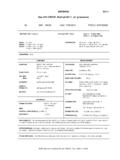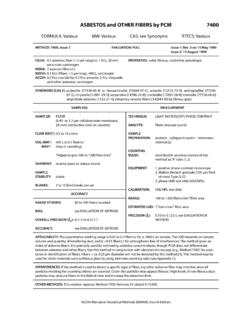Transcription of ASBESTOS by TEM 7402 - CDC
1 ASBESTOS by TEM7402 FORMULA: Various MW: Various CAS: Various RTECS: VariousMETHOD: 7402 EVALUATION: PARTIALI ssue 1: 15 May 1989 Issue 2: 15 August 1994 OSHA ASBESTOS fibers (>5 m long)/cc;1 f/cc/30 min excursion; carcinogenMSHA:2 ASBESTOS fibers/ f/cc (fibers > 5 m long)/400 L; crocidolite; amosite; 2 chrysotileand other ASBESTOS , fibers/cc; carcinogenPROPERTIES: solid, fibrous, crystalline, anistropicSYNONYMS [CAS#]:actinolite [77536-66-4] or ferroactinolite [15669-07-5]; amosite [12172-73-5]; anthophyllite [77536-67-5];chrysotile [12001-29-5]; serpentine [18786-24-8]; crocidolite [12001-28-4]; tremolite [77536-68-6]; amphibole ASBESTOS [1332-21-4].SAMPLINGSAMPLER:FILTER( to m cellulose ester membrane,25-mm diameter; conductive cassette)FLOW to 16 L/minVOL-MIN*:400 L @ fiber/cc -MAX*:(step 4, sampling)*Adjust for 100 to 1300 fibers/mm2 SHIPMENT:routine (pack to reduce shock)SAMPLE STABILITY:stableBLANKS:2 to 10 field blanks per setMEASUREMENTTECHNIQUE:MICROSCOPY, TRANSMISSIONELECTRON (TEM)ANALYTE: ASBESTOS fibersSAMPLEPREPARATION:modified Jaffe wickEQUIPMENT:transmission electron microscope; energydispersive X-ray system (EDX) analyzerCALIBRATION:qualitative electron diffraction; calibrationof TEM magnification and EDX systemRANGE:100 to 1300 fibers/mm2 filter area [1]ESTIMATED LOD:1 confirmed ASBESTOS fiber above 95% ofexpected mean blank valuePRECISION (S r) when 65% of fibers are ASBESTOS ; when adjusted fiber count is appliedto PCM count [2].
2 ACCURACYRANGE STUDIED:80 to 100 fibers countedBIAS:not determinedOVERALL PRECISION (S rT): see EVALUATION OFMETHODACCURACY:not determinedAPPLICABILITY: The quantitative working range is to fiber/cc for a 1000-L air sample. The LOD depends on samplevolume and quantity of interfering dust, and is < fiber/cc for atmospheres free of interferences. This method is used todetermine ASBESTOS fibers in the optically visible range and is intended to complement the results obtained by phase contrastmicroscopy (Method 7400).INTERFERENCES: Other amphibole particles that have aspect ratios greater than 3:1 and elemental compositions similar to theasbestos minerals may interfere in the TEM analysis. Some non-amphibole minerals may give electron diffraction patterns similarto amphiboles. High concentrations of background dust interfere with fiber identification. Some non- ASBESTOS amphibole mineralsmay give electron diffraction patterns similar to ASBESTOS methods : This method is designed for use with Method 7400 (phase contrast microscopy).
3 niosh manual of analytical methods ( nmam ), Fourth Edition, 8/15/94 ASBESTOS by TEM: METHOD 7402, Issue 2, dated 15 August 1994 - Page 2 of 7 (See SPECIAL PRECAUTIONS.)EQUIPMENT: : field monitor, 25-mm, three-piece cassette with ca. 50-mm electrically-conductiveextension cowl, cellulose ester membrane filter, to m pore size, and backup 1:Analyze representative filters for fiber background before use. Discard the filter lot ifmean count is >5 fibers/100 fields. These are defined as laboratory 2:Use an electrically-conductive extension cowl to reduce electrostatic effects on fibersampling and during sample shipment. Ground the cowl when possible 3 m pore size filters are recommended for personal sampling. m filters arerecommended for sampling when performing TEM analysis on the samples because theparticles deposit closer to the filter surface. However, the higher pressure drop throughthese filters normally preclude their use with personal sampling pumps.
4 Sampling pump, to 16 L/min, with flexible connecting tubing. , transmission electron, operated at ca. 100 kV, with electron diffraction andenergy-dispersive X-ray capabilities, and having a fluorescent screen with inscribed or overlaidcalibrated scale (Step 15).NOTE:The scale is most efficient if it consists of a series of lines inscribed on the screen or partialcircles every 2 cm distant from the center. grating replica with known number of lines/mm. , glass, pre-cleaned, 25- x 75-mm. , surgical steel, curved-blade. , 200-mesh TEM copper, (optional: carbon-coated). dishes, 15-mm depth. The top and bottom of the petri dish must fit snugly together. To assurea tight fit, grind the top and bottom pieces together with an abrasive such as carborundum toproduce a ground-glass contact , clean polyurethane, spongy, 12-mm , Whatman No. 1 qualitative paper or equivalent, or lens borer, (about 8-mm).
5 , waterproof, , page, standard bulk materials for reference; SRM #1866, available from the National Instituteof Standards and rods, sharpened to 1 mm x 8 , light, phase contrast (PCM), with Walton-Beckett graticule (see method 7400). wire, 22-gauge, , shrink- or PRECAUTIONS: Acetone is extremely flammable (flash point = 0 F). Take precautions notto ignite it. Heating of acetone must be done in a fume hood using a flameless, spark-free heat is a confirmed human carcinogen. Handle only in a well-ventilated fume manual of analytical methods ( nmam ), Fourth Edition, 8/15/94 ASBESTOS by TEM: METHOD 7402, Issue 2, dated 15 August 1994 - Page 3 of 7 each personal sampling pump with a representative sampler in personal sampling, fasten sampler to worker's lapel near worker's mouth. Remove the topcover from cowl extension ("open-face") and orient sampler face down. Wrap joint betweenextender and monitor body with tape to help hold the cassette together and provide a markingsurface to identify the cassette.
6 Where possible, especially at low %RH, attach sampler toelectrical ground to reduce electrostatic effects during at least two field blanks (or 10% of the total samples, whichever is greater) for each setof samples. Remove top covers from the field blank cassettes and store top covers andcassettes in a clean area ( , closed bag or box) during sampling. Replace top covers whensampling is at to 16 L/min [3]. Adjust sampling rate, Q (L/min), and time, t (min), to producefiber density, E, of 100 to 1300 fibers/mm2 [ 104 to 5 105 fibers per 25-mm filter witheffective collection area (Ac= 385 mm2)] for optimum accuracy. Do not exceed ca. mg totaldust loading on the filter. These variables are related to the action level (one-half the currentstandard), L (fibers/cc), of the fibrous aerosol being sampled by:NOTE:The purpose of adjusting sampling times is to obtain optimum fiber loading on the filter. A sampling rate of 1 to 4 L/min for 8 h (700 to 2800 L) is appropriate in atmospherescontaining ca.
7 Fiber/cc in the absence of significant amounts of non- ASBESTOS dust. Dusty atmospheres require smaller sample volumes ( 400 L) to obtain countablesamples. In such cases take short, consecutive samples and average the results overthe total collection time. For documenting episodic exposures, use high rates ( 7 to 16L/min) over shorter sampling times. In relatively clean atmospheres, where targetedfiber concentrations are much less than fiber/cc, use larger sample volumes (3000 to10000 L) to achieve quantifiable loadings. Take care, however, not to overload the filterwith background dust [3]. the end of sampling, replace top cover and small end samples upright with conductive cowl attached in a rigid container with packing material toprevent jostling or :Do not use untreated polystyrene foam in the shipping container because electrostaticforces may cause fiber loss from sample circular sections from any of three quadrants of each sample and blank filter using acork borer [4].
8 The use of three grid preparations reduces the effect of local variations in dustdeposit on the the circular filter sections to a clean glass slide with a gummed page reinforcement. Labelthe slide with a waterproof marking :Up to eight filter sections may be attached to the same the slide in a petri dish which contains several paper filters soaked with 2 to 3 mLacetone. Cover the dish. Wait 2 to 4 min for the sample filter(s) to fuse and :The "hot block" clearing technique [5] of Method 7400 or the DMF clearing technique [6]may be used instead of steps 8 and the slide to a rotating stage inside the bell jar of a vacuum evaporator. Evaporate a 1-by 5-mm section of a graphite rod onto the cleared filter(s). Remove the slide to a clean, dry,covered petri dish [4]. a second petri dish as a Jaffe wick washer with the wicking substrate prepared fromfilter or lens paper placed on top of a 12-mm thick disk of clean, spongy polyurethane foam [7]. niosh manual of analytical methods ( nmam ), Fourth Edition, 8/15/94 ASBESTOS by TEM: METHOD 7402, Issue 2, dated 15 August 1994 - Page 4 of 7 Cut a V-notch on the edge of the foam and filter paper.
9 Use the V-notch as a reservoir foradding :The wicking substrate should be thin enough to fit into the petri dish without touchingthe the TEM grid on the filter or lens paper. Label the grids by marking with a pencil on thefilter paper or by putting registration marks on the petri dish halves and marking with awaterproof marker on the dish lid. In a fume hood, fill the dish with acetone until the wickingsubstrate is :The level of acetone should be just high enough to saturate the filter paper withoutcreating about a quarter section of the carbon-coated filter from the glass slide using a surgicalknife and tweezers. Carefully place the excised filter, carbon side down, on theappropriately-labeled grid in the acetone-saturated petri dish. When all filter sections have beentransferred, slowly add more solvent to the wedge-shaped trough to raise the acetone level ashigh as possible without disturbing the sample preparations. Cover the petri dish. Elevate oneside of the petri dish by placing a slide under it (allowing drops of condensed acetone to formnear the edge rather than in the center where they would drip onto the grid preparation).
10 CALIBRATION AND QUALITY the TEM magnification on the fluorescent a field of view on the fluorescent screen either by markings or physical :The field of view must be measurable or previously inscribed with a scale orconcentric circles (all scales should be metric) [7]. a diffraction grating replica into the specimen holder and place into the microscope. Orient the replica so that the grating lines fall perpendicular to the scale on the TEMfluorescent screen. Ensure that goniometer stage tilt is microscope magnification to 10,000X. Measure the distance (mm) between the samerelative positions ( , between left edges) of two widely-separated lines on the gratingreplica. Count the number of spaces between the :On most microscopes the magnification is substantially constant only within thecentral 8- to 10-cm diameter region of the fluorescent the true magnification (M) on the fluorescent screen:where: X = total distance (mm) between the two grating lines;G = calibration constant of the grating replica (lines/mm);Y = number of grating replica spaces counted calibration, note the apparent sizes of and m on the fluorescent screen.












